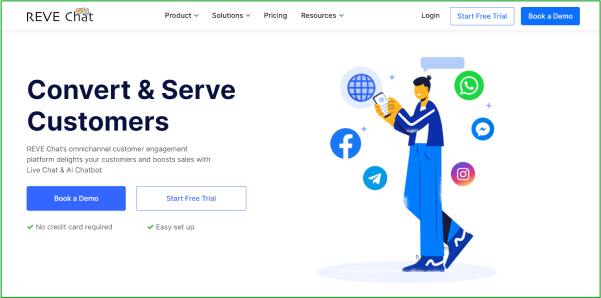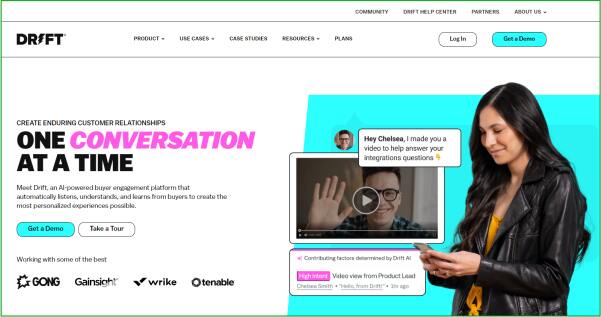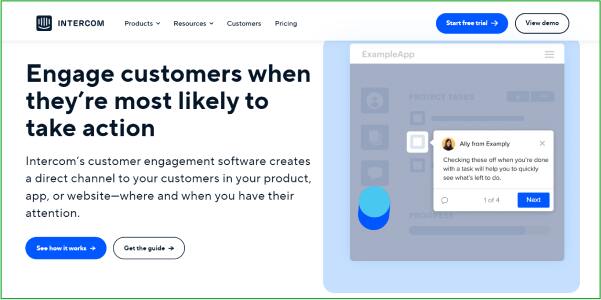The world of AI technology and its promising potential to revolutionize customer engagement. In this deep dive, we will explore how AI is set to transform the way businesses connect with their customers, creating personalized and meaningful interactions.
Imagine a future where companies truly understand their customers, anticipating their needs and desires. With AI, this future is becoming a reality. By analyzing vast amounts of data, AI algorithms gain insights that enable businesses to tailor their offerings to individual preferences, delivering exceptional experiences and increasing customer service strengths.
AI technology also enhances communication channels, introducing intelligent chatbots and virtual assistants that provide instant and accurate responses.
In this blog post, we will deeply explore how AI technology will transform customer engagement. Let’s see:
The Rise of AI Technology in Customer Engagement

AI technology can revolutionize customer engagement by offering better personalization, an improved customer experience (CX), and smooth all-channel experiences. It can predict consumer behavior, customize content, and optimize customer interactions.
The rise of AI technology in customer engagement refers to the increasing use of AI technology to enhance and improve customer engagement. This trend is observed across various industries, including the life sciences industry, digital marketing, and E-commerce customer service.
Here are some key ways AI is transforming customer engagement:
Enhanced Personalization:
AI enables businesses to deliver highly personalized experiences to their customers. Advanced data analysis and machine learning systems are conducting in-depth analyses. AI systems can understand customer preferences, behaviors, and needs.
This allows companies to tailor their offerings, recommendations, and communications to individual customers, thereby improving customer satisfaction and loyalty.
Smooth Customer Support:
AI-powered chatbots have become increasingly prevalent in customer engagement. These customer service bots use natural language processing and machine learning to interact with customers in real-time, providing immediate assistance and support.
Chatbots are available 24/7, ensuring that customers receive prompt responses to their queries, leading to improved customer service and reduced wait times.
Predictive Analytics:
As mentioned earlier, predictive analytics is a key part of AI in customer engagement. It allows businesses to predict customer behavior, trends, and outcomes based on historical and real-time data.
This empowers businesses to take preventive actions, personalize interactions, optimize marketing strategies, and ultimately enhance customer satisfaction.
Enhanced Efficiency:
AI technology in customer engagement brings enhanced efficiency to businesses. Through artificial intelligence and intelligent systems, AI can streamline processes, reduce manual effort, and optimize resource sharing.
Tasks that were once time-consuming and repetitive can now be automated, allowing employees to focus on more strategic and value-added activities. This improved efficiency leads to cost savings, faster response times, and increased productivity.
Improved customer satisfaction:
AI technology enhances customer satisfaction by providing personalized and prompt service. With AI-powered chatbots, customers can receive immediate assistance at any time, reducing wait times and frustration.
AI systems also enable businesses to analyze customer data and offer tailored recommendations, ensuring that customers receive relevant and helpful information. This personalized approach increases customer satisfaction and loyalty.
New Opportunities:
The rise of AI in customer engagement opens up new opportunities for businesses. AI can help identify patterns and trends in customer behavior, enabling companies to anticipate needs and proactively address issues.
Additionally, AI-powered analytics provide insights into customer preferences, allowing businesses to develop targeted marketing strategies, improve their new customer service tools, and also optimize their offerings. These opportunities help businesses stay competitive and adapt to evolving customer demands.
The potential of AI:
The potential of AI in customer engagement is wide. As AI technology continues to improve, it can offer even more elegant and personalized experiences. AI algorithms can also integrate with other technologies.
such as virtual reality or augmented reality, to create immersive customer experiences. The potential for AI to revolutionize customer engagement is limitless in the customer service industry, with ongoing advancements and innovation.
7 Ways AI Technology Will Transform Customer Engagement
Artificial intelligence is swiftly changing how businesses communicate with customers. How to improve customer service skills has become easier with AI. Companies can personalize experiences, automate tasks, and gain valuable insights by utilizing AI capabilities, resulting in enhanced customer engagement and loyalty.
Here are some ways AI technology will transform customer engagement
1. Hyper-personalization

The goal of hyper-personalization is to provide customers with relevant and personalized experiences that align with their specific needs and interests. Hyper-personalization is a strategy that leverages advanced technologies, such as artificial intelligence (AI) and machine learning, to deliver highly personalized and individualized experiences to customers. By understanding each customer on a deep level, businesses can deliver targeted messages and offers that are more likely to connect with and engage them.
There are several key elements of hyper-personalization:
- Data collection: Hyper-personalization relies on the collection of customer data from various sources, such as website interactions, social media activity, previous purchases, and demographic information. This data provides valuable insights into customer preferences and behaviors.
- Personalized content: Businesses can create and deliver personalized content to customers based on the insights gained from data analysis. This includes targeted product recommendations, customized marketing messages, and personalized offers that are tailored to each individual’s preferences.
- Real-time adaptation: Hyper-personalization is not a one-time effort. It requires continuous monitoring and adaptation based on customer interactions and feedback. By tracking customer behavior in real-time, businesses can make immediate adjustments to ensure ongoing relevance and effectiveness.
- Omnichannel integration: Hyper-personalization extends across multiple channels and touchpoints, including websites, mobile apps, email, social media, and offline interactions. By integrating personalization efforts smoothly across channels, businesses can provide a consistent experience for customers.
The benefits of hyper-personalization
- Enhanced customer engagement: By delivering personalized experiences, businesses can capture customer attention and foster deeper engagement. Personalized content and recommendations make customers feel valued and understood, increasing their loyalty and support.
- Improved conversion: When customers receive personalized offers that align with their preferences and needs, they are more likely to convert. Hyper-personalization improves conversion rates by delivering the right message to the right customer at the right time.
- Increased customer satisfaction: Personalized experiences that cater to individual preferences lead to higher customer satisfaction. When customers feel that a brand understands their unique needs, they are more likely to be satisfied with their interactions and overall experience.
- Stronger customer relationships: Hyper-personalization helps build stronger relationships with customers by demonstrating a deep understanding of their preferences and consistently meeting their individual needs. This can lead to long-lasting customer loyalty and advocacy.
2. Enhanced Customer Service
AI technology has the potential to completely change customer service, turning it from a customized, reactive process to a proactive one. This “Deep dive” examines how AI transforms customer engagement and improves customer service.
Enhanced customer service refers to the practice of improving and elevating AI-powered customer support. It involves implementing strategies and utilizing tools to ensure that customers receive timely, efficient, and personalized assistance throughout their interaction with a business.
There are several key elements of enhanced customer service:
- Preventive communication: Enhanced customer service involves proactive reaching out to customers to provide updates, offer assistance, or address any potential concerns. This can be done through various channels, such as email, phone calls, or proactive live chat customer service.
- Multi-channel support: Offering support through multiple channels allows customers to choose the most convenient option for chatbots in customer service. Whether it’s phone, email, live chat, social media, or self-service portals, businesses should ensure consistent and accessible support across all channels.
- Empathetic approach: Indicating empathy and understanding towards customers’ concerns and upsets is crucial to providing enhanced service. Empathetic interactions help build trust, show that the business values its customers, and can lead to increased customer satisfaction and loyalty.
- Continuous improvement: Enhanced customer service requires a commitment to continuous improvement. By collecting feedback, analyzing customer interactions, and identifying areas for improvement, businesses can refine their processes and enhance the overall customer experience.
Benefits of enhanced customer service with AI:
- 24/7 availability: AI-powered chatbots can provide continuous customer support, ensuring that assistance is available at any time. This eliminates the need to wait for human agents and improves customer satisfaction.
- Improved efficiency: Customer service tools such as chatbots and virtual assistants can handle customer inquiries and resolve common issues quickly and efficiently. This reduces the workload on human agents and allows them to focus on more complex tasks.
- Cost savings: implementing AI in customer service can lead to significant cost savings for businesses. Businesses may lower labor expenses without sacrificing the quality and effectiveness of the service they provide by automating routine processes and lowering the need for human agents.
- Data-driven insights: AI can analyze customer interactions and gather valuable insights. By examining patterns and trends, the customer service industry can identify areas for improvement, optimize processes, and make data-driven decisions to enhance the overall customer experience.
3. Conversational AI
Conversational AI is a technology that enables human-like interactions between computers and humans through natural language processing and machine learning algorithms. It uses various elements to create engaging and personalized conversations with users.
Here are some key elements of conversational AI
- Chatbot technology systems maintain contextual awareness throughout a conversation, remembering previous interactions, user preferences, and relevant information. This enables more personalized and tailored responses.
- Conversational AI can incorporate multiple modes of communication, such as text, voice, images, and even gestures. This enhances user engagement and provides flexibility for users to interact using their preferred mode
- Communicative artificial intelligence systems can handle multiple conversations simultaneously, ensuring scalability and availability for users. This allows businesses to provide round-the-clock support and engage with users at any time.
Some Benefits of Conversational AI:
- 24/7 availability and conversational AI, businesses can provide round-the-clock support, answering customer queries and resolving issues at any time, leading to increased customer convenience.
- Conversational AI offers personalized and interactive experiences, engaging customers in natural language conversations and enhancing overall satisfaction.
- Chatbot technology systems can provide instant responses, accurate information, and personalized recommendations, delivering a high level of customer service and support.
4. Multichannel Experiences
Multichannel experiences refer to the use of multiple channels or platforms to engage with customers and provide a seamless and consistent experience across different touchpoints. It involves various elements and offers several benefits.
Elements of multichannel experiences:
- Multiple channels: Businesses utilize various channels, such as websites, social media, mobile apps, physical stores, email, chatbots, and more, to interact with customers.
- Personalization: Tailoring interactions based on customer preferences, behaviors, and demographics is key to delivering personalized experiences across multiple channels.
- Consistency: Maintaining a consistent brand image, tone, and messaging across all channels helps reinforce brand identity and recognition.
- Integration: Efforts are made to integrate different channels and systems to ensure data and information flow smoothly across platforms. This enables a unified customer view and consistent messaging.
Benefits of multichannel experiences with AI:
- AI-powered multichannel experiences ensure a seamless shopping journey across various platforms, resulting in increased customer engagement and satisfaction.
- Conversational AI platforms allow for seamless conversations that can transition between different channels while maintaining context, providing a personalized and cohesive customer experience.
- AI enables businesses to personalize their marketing campaigns and target specific customer segments, resulting in more effective and tailored communication.
- AI streamlines customer service processes by providing support across different channels, such as email, social media, and chat, delivering a consistent and efficient customer experience.
5. Predictive Analytics
Predictive analytics is a data analysis technique that utilizes historical and current data to make predictions about future events or outcomes
Here are some elements of predictive analytics:
- Insightful forecasting starts with collecting and preparing relevant data from various sources. This involves gathering structured and unstructured data, cleaning it, and ensuring its quality and reliability.
- Predictive analytics involves selecting and engineering the most relevant features or variables that are likely to have a significant impact on the outcome being predicted.
The benefits of predictive analytics:
- This helps in delivering personalized recommendations, targeted marketing campaigns, and customized products or services, leading to enhanced customer satisfaction and loyalty.
- Predictive analytics allows businesses to optimize resource allocation by accurately predicting demand, optimizing inventory levels, and streamlining production processes.
6. AI-driven Customer Journey Mapping
AI-driven customer journey mapping refers to the use of artificial intelligence (AI) technology to analyze and optimize the customer journey.
Customer journey mapping involves understanding and representing the various touchpoints and interactions a customer has with a brand throughout their entire journey, from initial awareness to customer service.
Here’s how AI is transforming customer journey mapping:
- Boosting brand awareness: AI enables businesses to analyze customer data and preferences to deliver personalized content and recommendations, increasing brand awareness and visibility.
- Personalized content: through AI-powered systems and predictive analytics, businesses can tailor content and messaging to individual customers, providing them with highly relevant and personalized experiences.
- Customer journey arrangement: AI-powered customer journey mapping allows businesses to arrange and automate personalized customer journeys across multiple channels, ensuring consistent and smooth experiences.
- Data collection and analysis: AI technologies can collect and analyze wide amounts of customer data from multiple sources, such as CRM systems, social media, website analytics, and customer feedback.
Benefits of ai-powered customer journey mapping include
- Enhanced personalization: AI enables businesses to deliver personalized experiences by understanding individual customer preferences and providing relevant content and recommendations.
- Improved efficiency: automation and AI-powered tools streamline processes, reducing manual effort and improving operational efficiency.
- Increased customer satisfaction: by optimizing touchpoints and addressing pain points, businesses can provide a seamless and satisfying customer experience.
- Better decision-making: AI-powered insights and analytics provide businesses with data-driven insights to make informed decisions about improving the customer journey.
7. Ethical Considerations and Data Privacy

Ethical considerations and data privacy are essential components in the use of AI-powered customer engagement tools. They involve various elements and offer several benefits. Let’s explore them in detail:
Elements of ethical considerations and data privacy:
- Businesses should be transparent about how AI is used in customer engagement, including data collection, processing, and storage practices.
- Customers should provide open consent for their data to be collected and used, with clear information on how it will be utilized.
- Personally identifiable information should be anonymized or aggregated whenever possible to protect individual privacy.
- Loyalty to relevant data protection and privacy regulations, such as GDPR and CCPA, is crucial to protecting customer data rights.
Benefits of ethical AI:
- Demonstrating a strong commitment to data privacy can enhance a company’s reputation, attracting customers who value responsible data handling.
- Following data protection regulations helps businesses avoid legal repercussions and maintain compliance with industry standards.
- Ethical data practices ensure that customer information is handled responsibly, leading to a positive customer experience and increased satisfaction.
- When customers trust a business with their data, it allows for more accurate personalization of products, services, and communications, resulting in a tailored customer experience.
Challenges in Transforming Customer Engagement With AI
Transforming customer engagement with AI comes with several challenges.
Here are some key points summarizing the challenges:
Challenges:
- Balancing the desire for personalized experiences with customer privacy concerns can be challenging. Customers want personalized interactions but also expect their data to be protected.
- Using AI to retain customers and reduce churn requires identifying early warning signs and implementing preventive strategies. It is essential to understand customer behavior patterns and deliver targeted interventions.
- Implementing AI-driven customer engagement solutions can incur significant costs, including technology infrastructure, data management, and talent acquisition. Businesses must carefully evaluate their economic capability and return on investment.
- Applying AI technologies and combining them with existing systems can be complex. It requires expertise in AI algorithms, data integration, and system compatibility.
Tips for Overcoming Challenges
Businesses can transform customer engagement, build stronger relationships, and achieve long-term success by harnessing the power of AI.
Here are some tips for overcoming challenges
- Organize transparency and trust by openly communicating with customers about data usage, privacy measures, and the benefits of AI-driven engagement.
- Invest in data management processes to ensure data quality, security, accessibility, and compliance with relevant regulations.
- Focus on skills development through training programs to equip employees with AI expertise and the necessary skills for implementation.
- Collaborate with AI vendors, consultants, or customer service industry experts to leverage their expertise and guidance in implementing AI-driven customer engagement solutions.
- Continuously monitor AI models’ performance, collect feedback from customers, and iterate on the solutions to refine and improve customer engagement strategies.
By proactively addressing these challenges and implementing best practices, businesses can leverage AI to transform customer engagement and achieve significant competitive advantages.
Top 5 AI-powered Customer Engagement Tools
AI-powered customer engagement tools are revolutionizing the way businesses interact with their customers. These tools enable businesses to personalize experiences, automate tasks, and strengthen customer service capabilities. As a result, customer engagement and loyalty are significantly enhanced.
Here are the top 5 AI-powered customer engagement tools:
1. REVE Chat

REVE Chat provides a set of AI-powered customer engagement tools designed to assist businesses in enhancing their relationships with customers.
REVE Chat’s AI-powered customer engagement tools can help businesses:
- Reduce customer wait times
- Improve customer satisfaction
- Increase sales
- Build stronger relationships with customers
- Gain valuable insights into customer behavior
If you’re looking for a way to improve your customer engagement, REVE Chat is a great option to consider.
2. Salient
Salient is an AI-powered customer engagement tool that helps businesses optimize their customer interactions. With its advanced features and capabilities, Salient enables businesses to provide personalized experiences, streamline customer support, and enhance overall customer satisfaction.
3. Drift

Drift Is a conversational marketing platform that uses AI to power chatbots and virtual assistants. It enables businesses to engage with customers in real-time, automate lead generation, and deliver targeted messages based on customer behavior and preferences.
4. Intercom Engage

Intercom Engage offers AI-powered customer engagement tools like chatbots and live chat. Its AI assistant, operator, can handle routine customer inquiries, qualify leads, and schedule appointments, allowing businesses to provide efficient and personalized support.
5. Zendesk

Zendesk offers AI-powered customer engagement tools that enable businesses to provide personalized support and assistance. Its AI-powered chatbot, the answer bot, can automatically answer common customer queries, freeing up agents’ time for more complex issues.
Conclusion
AI technology will completely transform consumer engagement. Only users can explain how AI technology can transform customer engagement. AI-powered chatbots and virtual assistants can provide personalized and instant responses, delivering exceptional customer experiences.
AI technology enables multi-modal communication, allowing customers to engage through various channels, be they text, voice, or even images.
The combination of simplicity and flexibility improves customer-business engagement and connection overall. With AI’s limitless potential for consumer interaction, organizations get ahead of the competition, form deep connections with their customers, and provide outstanding customer service. To ensure that client engagement improves in the future, join the AI
Hi, this is Rafeoun Islam. I am a content writer and I write SEO-optimized content that helps to push traffic to the website. Currently, I'm working on content marketing, social media marketing, and affiliate marketing.
 Customer Engagement
Customer Engagement








